Research on Air Distribution Control Strategy of Supercritical Boiler †
Abstract
1. Introduction
2. Geometric and Physical Model
2.1. Geometric Model
2.2. Physical Model
2.2.1. Gas Phase Turbulence Model
2.2.2. Particle Flow Model
2.2.3. Volatilization Separate out Model
2.2.4. Volatile Combustion Model
2.2.5. Coke Combustion Model
2.2.6. NOX Generation Model
2.3. Radiation Model
2.4. Characteristic of Coal and Gases
2.5. Boundary Conditions
3. The Optimal Air Distribution Method under Typical Loads
4. Simulation and Air Distribution Mode Selection
4.1. Cold State Simulation
4.2. Combustion Simulation
4.3. Optimal Air Distribution Mode
5. Determine the Adjustment Strategy of Air Distribution
5.1. The Influence of the Combustion Air Damper Opening Adjustment
5.2. Effect of Adjusting the Opening of the Secondary Dampers
5.3. Air Distribution Control Strategy
6. Conclusions
Author Contributions
Funding
Data Availability Statement
Conflicts of Interest
References
- Han, S.; Iop. Research on the market mechanism of generation grid load storage interaction to promote new energy consumption. In Proceedings of the 2020 International Symposium On Energy Environment and Green Development, Chongqing, China, 20 November 2020. [Google Scholar]
- Stanytsina, V.; Artemchuk, V.; Bogoslavska, O.; Zaporozhets, A.; Kalinichenko, A.; Stebila, J.; Havrysh, V.; Suszanowicz, D. Fossil Fuel and Biofuel Boilers in Ukraine: Trends of Changes in Levelized Cost of Heat. Energies 2022, 15, 7215. [Google Scholar] [CrossRef]
- Horbaniuc, B.; Marin, O.; Dumitraşcu, G.; Charon, O. Oxygen-enriched combustion in supercritical steam boilers. Energy 2004, 29, 427–448. [Google Scholar] [CrossRef]
- Bartela, Ł.; Gładysz, P.; Ochmann, J.; Qvist, S.; Sancho, L.M. Repowering a Coal Power Unit with Small Modular Reactors and Thermal Energy Storage. Energies 2022, 15, 5830. [Google Scholar] [CrossRef]
- Lyu, J.F.; Yang, H.R.; Ling, W.; Nie, L.; Yue, G.X.; Li, R.X.; Chen, Y.; Wang, S.L. Development of a supercritical and an ultra-supercritical circulating fluidized bed boiler. Front. Energy 2019, 13, 114–119. [Google Scholar] [CrossRef]
- Ma, D.F.; Hao, X.H. Status and Prospect of Large-scale Circulating Fluidized Bed Boiler. Adv. Mater. Res. 2012, 516–517, 444–447. [Google Scholar] [CrossRef]
- Wang, Y.H.; Li, X.Y.; Mao, T.Q.; Hu, P.F.; Li, X.C. Mechanism modeling of optimal excess air coefficient for operating in coal fired boiler. Energy 2022, 261, 125128. [Google Scholar] [CrossRef]
- Johar, C. Leveraging CFD to Boost HVAC System Engineering. ASHRAE J. 2018, 60, 68–72. [Google Scholar]
- Arab, M.A.; Gamil, A.I.; Syam, T.; Umer, M.; Ghani, S.; IEEE. Air Expulsion Analysis of an Industrial Air Valve Using CFD. In Proceedings of the 2021 12th International Conference On Mechanical And Aerospace Engineering (ICMAE), Virtual Conference, 9–12 December 2021; pp. 552–557. [Google Scholar]
- Xiao, H.; Bai, J.B.; Wu, Y.G.; Wang, J.Q.; Yang, X.H.; Zhang, G.F. Dynamic simulation of a large scale 260t/h CFB boiler Based on SIMUCAD Platform. In Proceedings of the 2009 ISECS International Colloquium On Computing, Communication, Control, And Management, Sanya, China, 8-9 August 2009; Volume IV, pp. 246–249. [Google Scholar]
- Kang, Y.W.; Xue, Y.; Huang, W.; Li, Y.F. A Nonlinear Lumped-parameter Dynamic Model of Power Plant Boiler Superheater. Adv. Mater. Res. 2013, 732–733, 57–62. [Google Scholar] [CrossRef]
- Shen, H.S.; Wu, Y.X.; Zhou, M.M.; Zhang, H.; Yue, G.X.; Lyu, J.F. Large eddy simulation of a 660 MW utility boiler under variable load conditions. Front. Energy 2021, 15, 124–131. [Google Scholar] [CrossRef]
- Hernik, B.; Zablocki, W. Numerical research of combustion with a minimum boiler load. Arch. Thermodyn. 2020, 41, 93–114. [Google Scholar] [CrossRef]
- Wang, C.L.; Liu, Y.; Zheng, S.; Jiang, A.P. Optimizing combustion of coal fired boilers for reducing NOx emission using Gaussian Process. Energy 2018, 153, 149–158. [Google Scholar] [CrossRef]
- Horvath, Z.; Jandacka, J.; Malcho, M. Simulation of air flow in hot-air boiler. In Proceedings of the Experimental Fluid Mechanics 2006, Liberec, Czech Republic, 6–7 December 2016; pp. 73–78. [Google Scholar]
- Fang, F.; Sun, L.L. Joint Modeling and Simulation of Furnace Combustion. In Proceedings of the 29th Chinese Control Conference, Chongqing, China, 28–30 May 2017; pp. 1307–1312. [Google Scholar]
- Epelbaum, G.; Zhang, H.W. Process Simulation of a large mass burn Waste-Tb-Energy boiler by the combination of CFD software programs. Prog. Comput. Fluid Dyn. 2007, 7, 11–18. [Google Scholar] [CrossRef]
- Kraszkiewicz, A. The Combustion of Wood Biomass in Low Power Coal-Fired Boilers. Combust. Sci. Technol. 2016, 188, 389–396. [Google Scholar] [CrossRef]
- Rastvorov, D.V.; Osintsev, K.V.; Toropov, E.V. Influence of burner form and pellet type on domestic pellet boiler performance. IOP Conf. Ser. Earth Environ. Sci. 2017, 87, 032034. [Google Scholar] [CrossRef]
- Ahn, J.; Jang, J.H. Combustion and heat transfer characteristics in a combustion chamber of a 13-step grate wood pellet firing boiler. J. Mech. Sci. Technol. 2018, 32, 1033–1040. [Google Scholar] [CrossRef]
- Zhang, B.T.; Wang, C.Y.; Qin, Q.; Li, L. Influence of Boiler Combustion Adjustment on NOx Emission and Boiler Efficiency. Adv. Mater. Res. 2013, 732–733, 234–237. [Google Scholar]
- Chen, H.W.; Liang, Z.W. Damper opening optimization and performance of a co-firing boiler in a 300 MWe plant. Appl. Therm. Eng. 2017, 123, 865–873. [Google Scholar] [CrossRef]
- Li, S.; Xu, T.M.; Hui, S.; Wei, X.L. NOx emission and thermal efficiency of a 300 MWe utility boiler retrofitted by air staging. Appl. Energy 2009, 86, 1797–1803. [Google Scholar] [CrossRef]
- Arablu, M.; Poursaeidi, E. Using CFD for NO (x) emission simulation in a dual fuel boiler. Combust. Explos. Shock. Waves 2011, 47, 426–435. [Google Scholar] [CrossRef]
- Jin, Y.; Zhang, X.; Zhang, Y.; Quan, M.; Xing, Y. Analysis of Numerical Simulation and Strategy Overview of a 350 mw Supercritical Boiler Air Distribution Regulation. In Proceedings of the 17th UK Heat Transfer Conference (UKHTC2021), Manchester, UK, 5–7 September 2021. [Google Scholar]
- Han, X.; Sagaut, P.; Lucor, D. On sensitivity of RANS simulations to uncertain turbulent inflow conditions. Comput. Fluids 2012, 61, 2–5. [Google Scholar] [CrossRef]
- Torresi, J.; Ebert, G.; Pellegrini, M. Vaccines licensed and in clinical trials for the prevention of dengue. Hum. Vaccines Immunother. 2017, 14, 1–14. [Google Scholar] [CrossRef] [PubMed]
- Ramanujachari, V.; Balakrishna, S.; Ganesan, S. Probability density function approach to non-premixed turbulent flames. Indian J. Pure Appl. Math. 2000, 31, 1339–1351. [Google Scholar]
- Hafiz, M.; Nelwan, L.O.; Yulianto, M. CFD-based Analysis of Non-Premixed Combustion Model in Biomass Grate Furnaces. In Proceedings of the 2nd International Conference on Agricultural Engineering For Sustainable Agricultural Production (Aesap 2017), Bogor, Indonesia, 23–25 October 2017. [Google Scholar]
- Bartonova, L. Element behaviour in coal combustion—Comparison of element contents in unburnt carbon, coal and bottom ash. Chem. Listy 2006, 100, 798–802. [Google Scholar]
- Dong, H.; Zhang, Y.; Du, Q.; Gao, J.; Shang, Q.; Feng, D.; Huang, Y. Generation and Emission Characteristics of Fine Particles Generated by Power Plant Circulating Fluidized Bed Boiler. Energies 2022, 15, 6892. [Google Scholar] [CrossRef]
- Gao, Z.Y.; Chen, D.F.; Du, W.Y.; Wu, X.F.; Wang, X.J.; IEEE. Numerical Investigation on the NO Emissions of W-shaped Boiler At Different Air Distributions. In Proceedings of the 2010 Asia-Pacific Power And Energy Engineering Conference (APPEEC), Chengdu, China, 28–31 March 2010. [Google Scholar]
- Zhijun, S.; Sheng, S.; Xing, N.; Jun, X.; Qi, L.; Yun, Z.; Lushi, S.; Song, H.; Jun, X.; Anchao, Z. The Investigation of NOx Formation and Reduction during O2/CO2 Combustion of Raw Coal and Coal Char. Energy Procedia 2015, 66, 69–72. [Google Scholar] [CrossRef]
- Nie, L.; Lu, J.Y.; Deng, Q.G.; Gong, L.M.; Xue, D.Y.; Yang, Z.Z.; Lu, X.F. Study on the Uniformity of Secondary Air of a 660 MW Ultra-Supercritical CFB Boiler. Energies 2022, 15, 3604. [Google Scholar] [CrossRef]
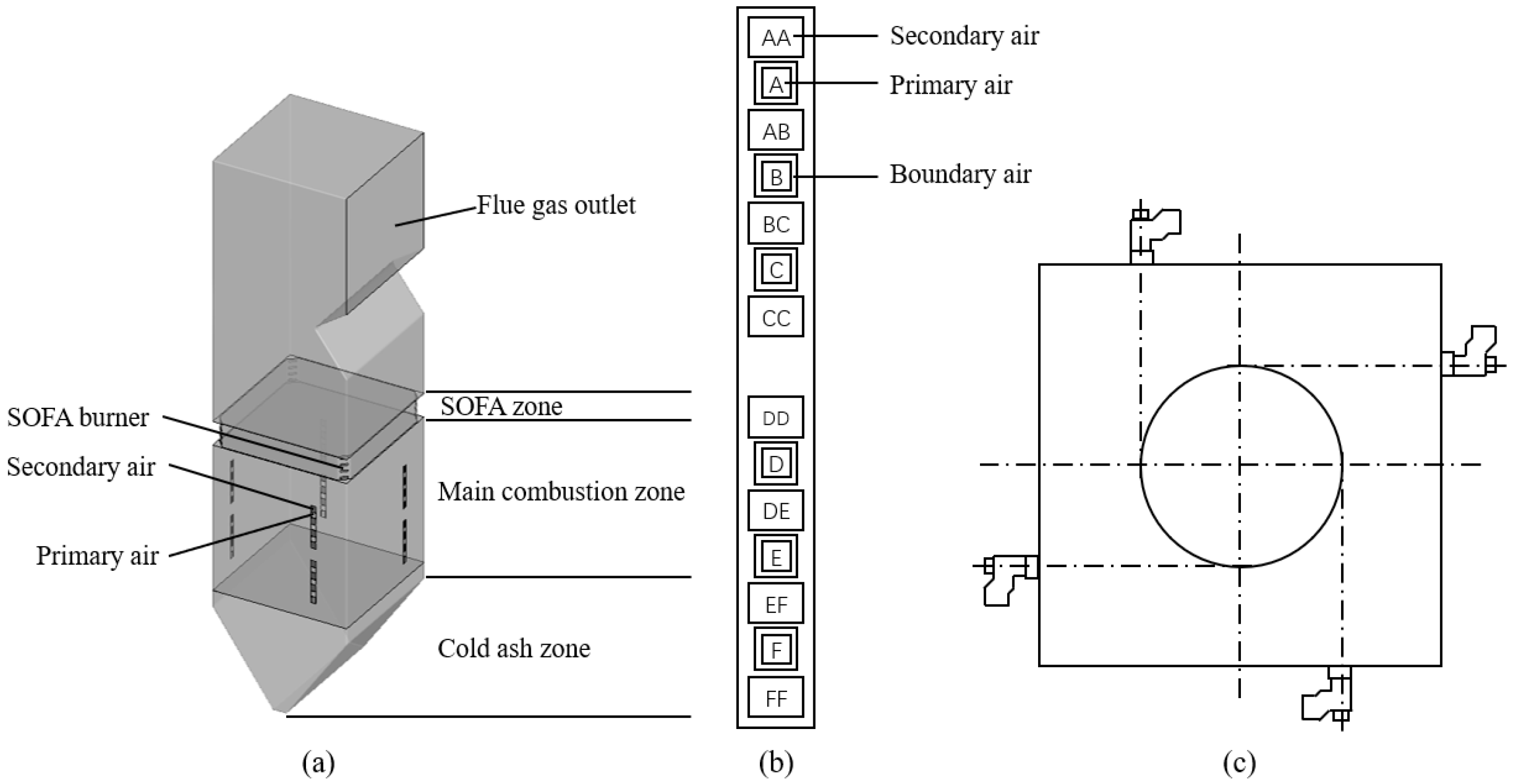
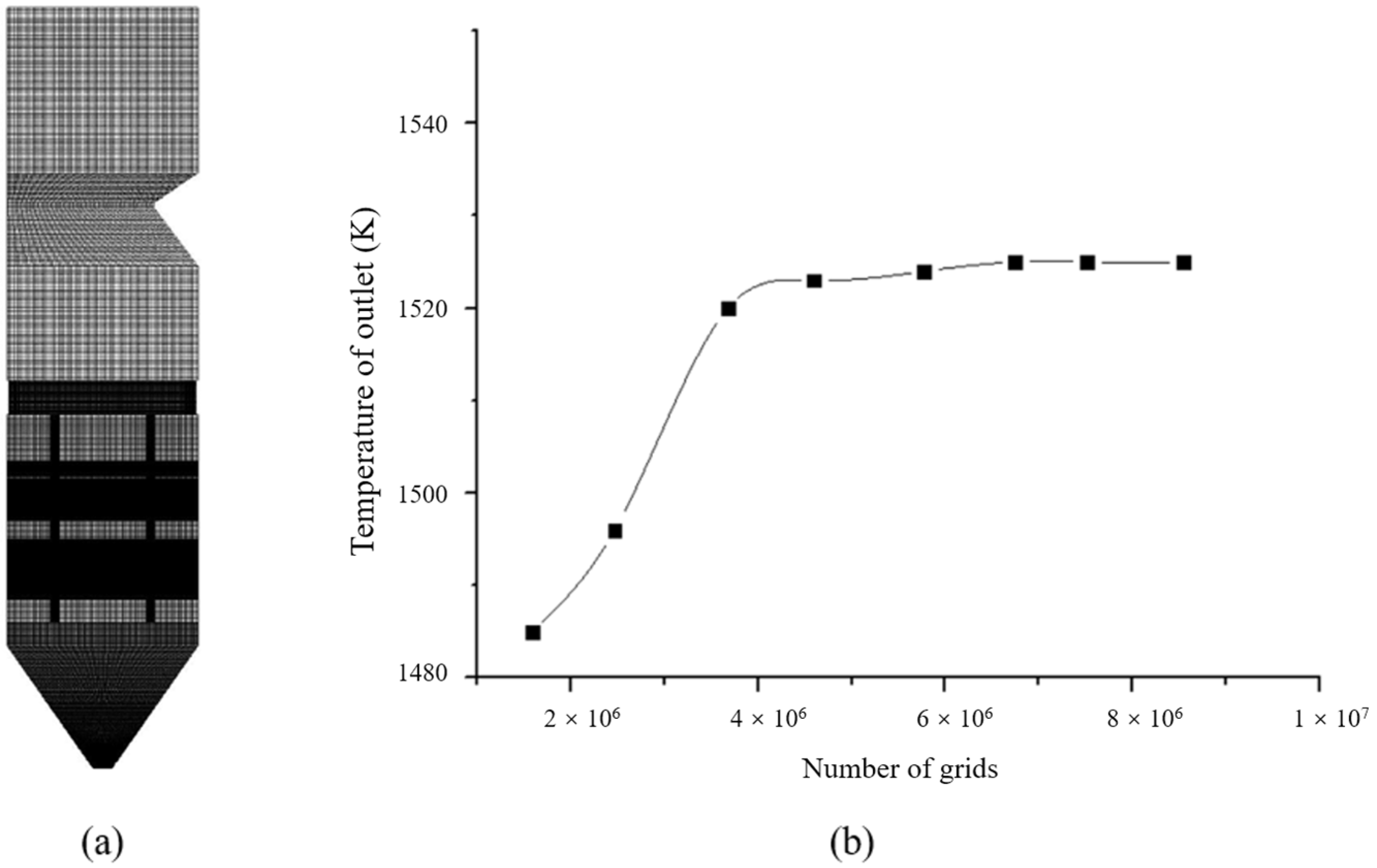
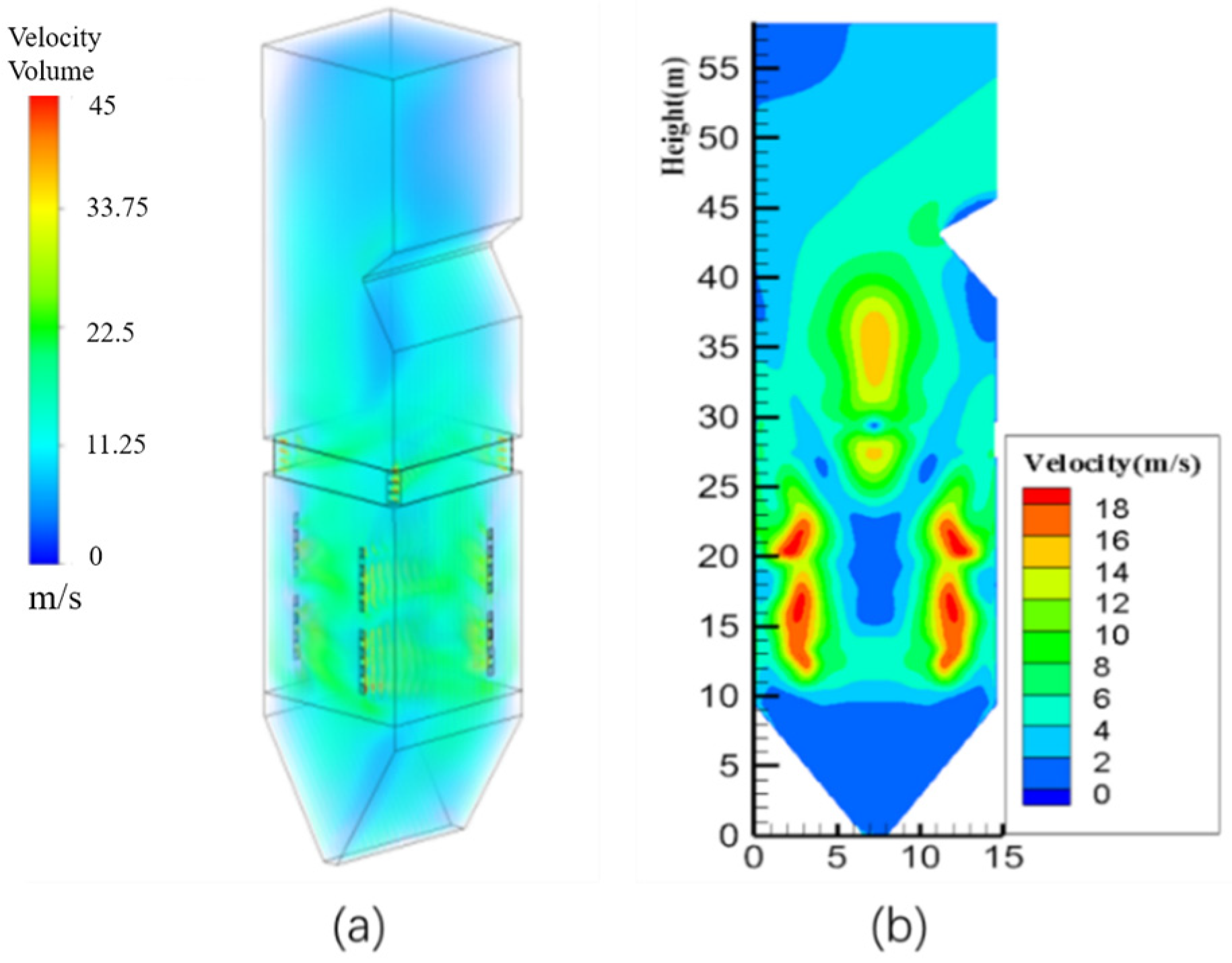
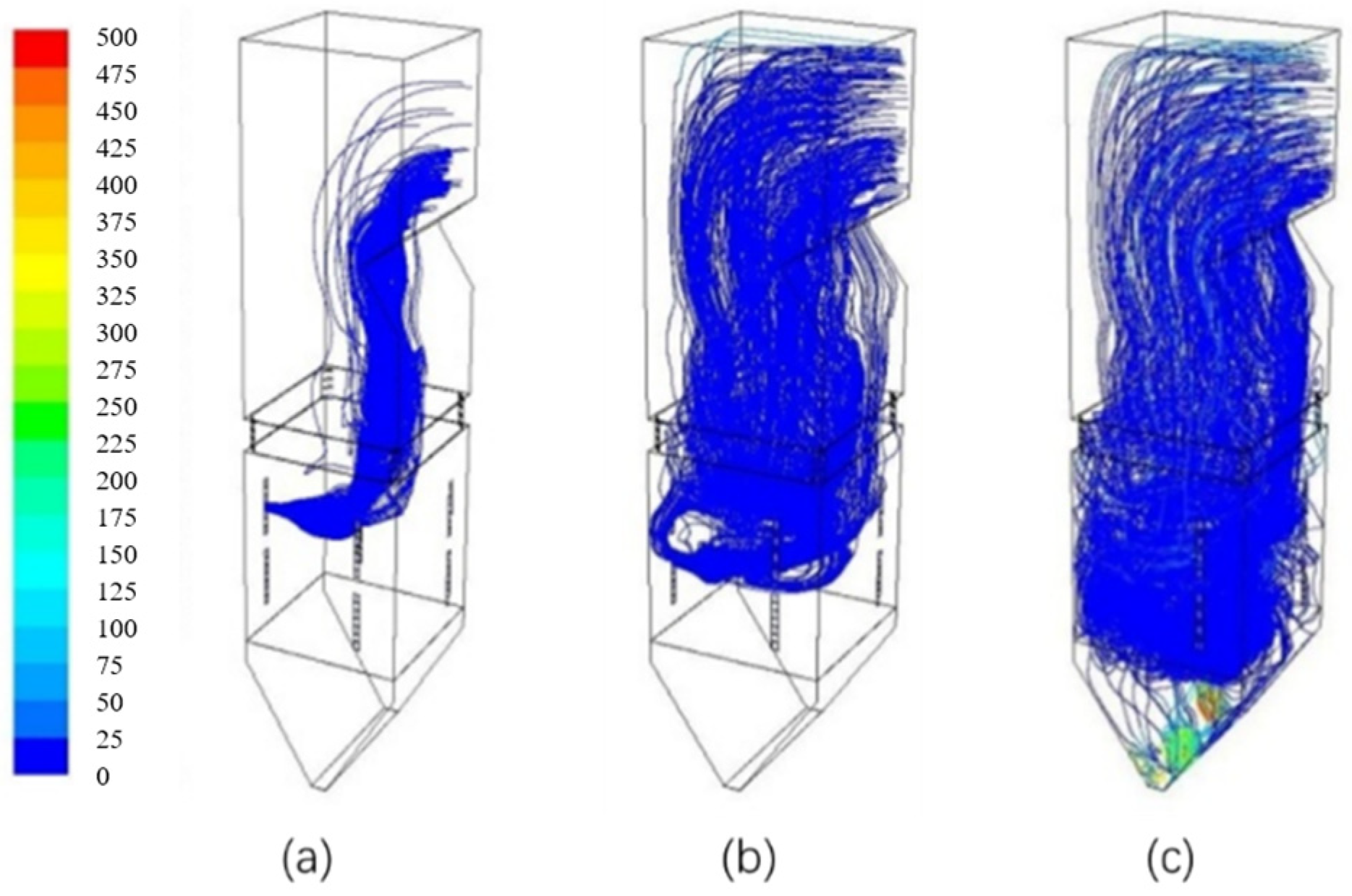
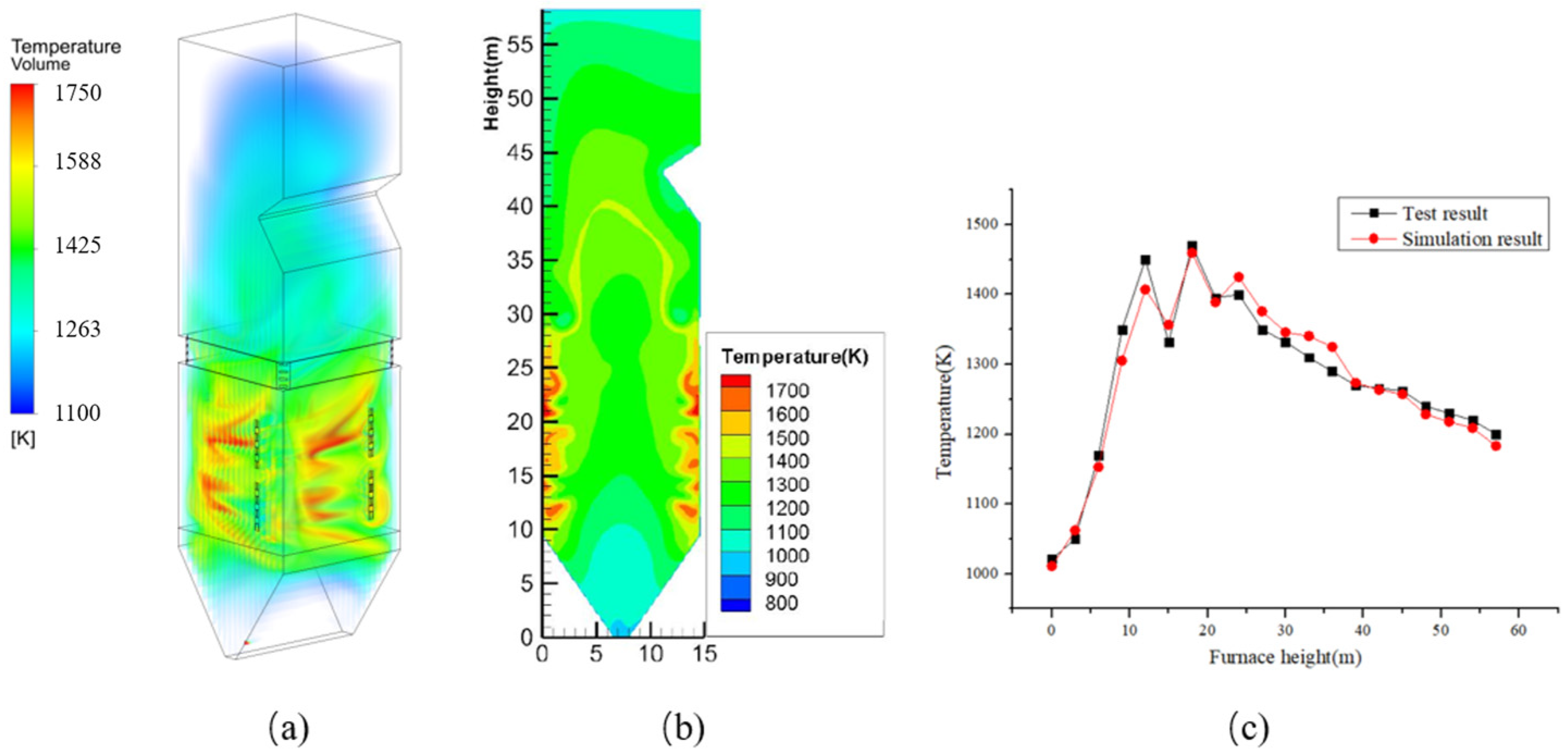
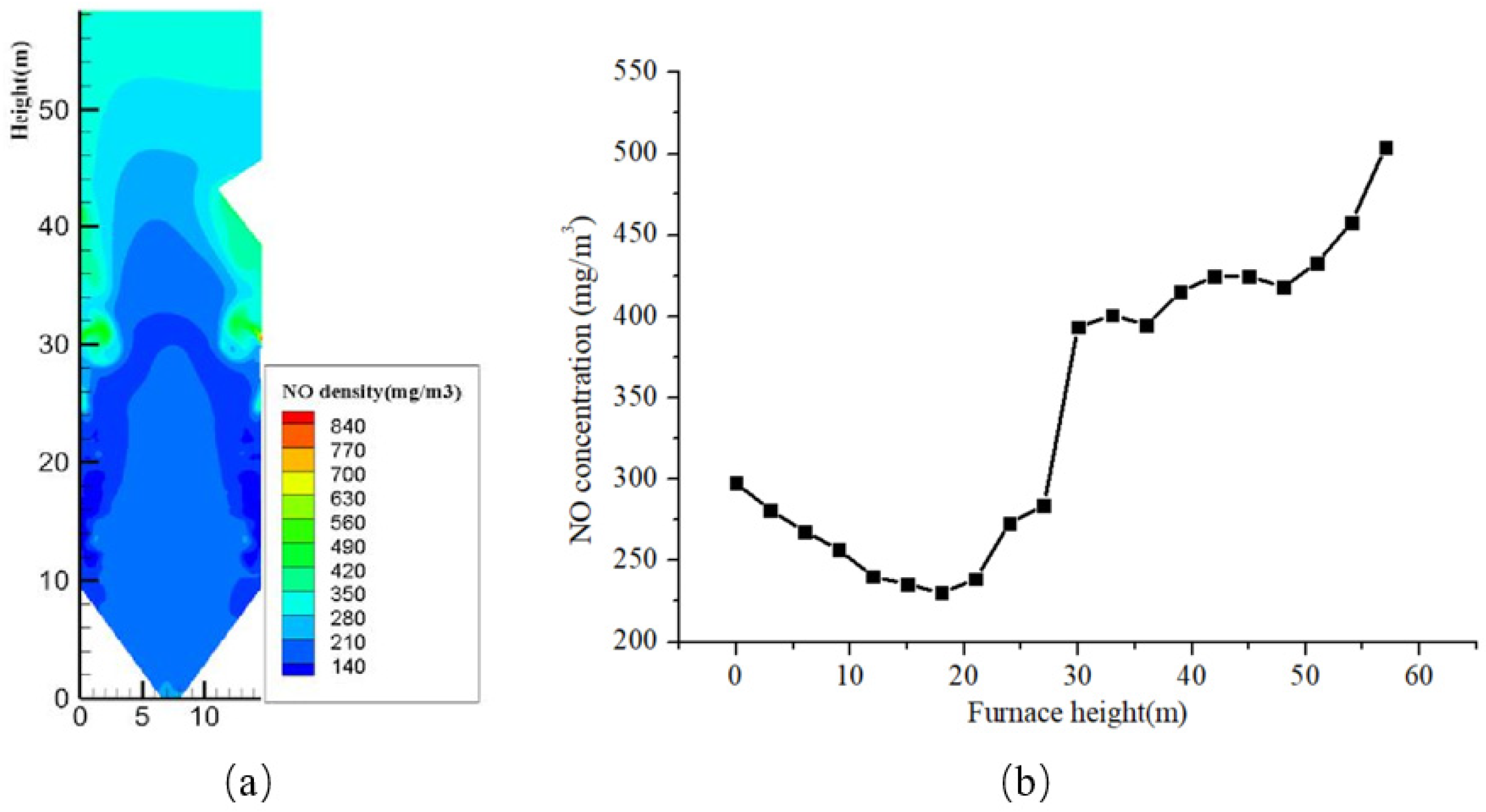
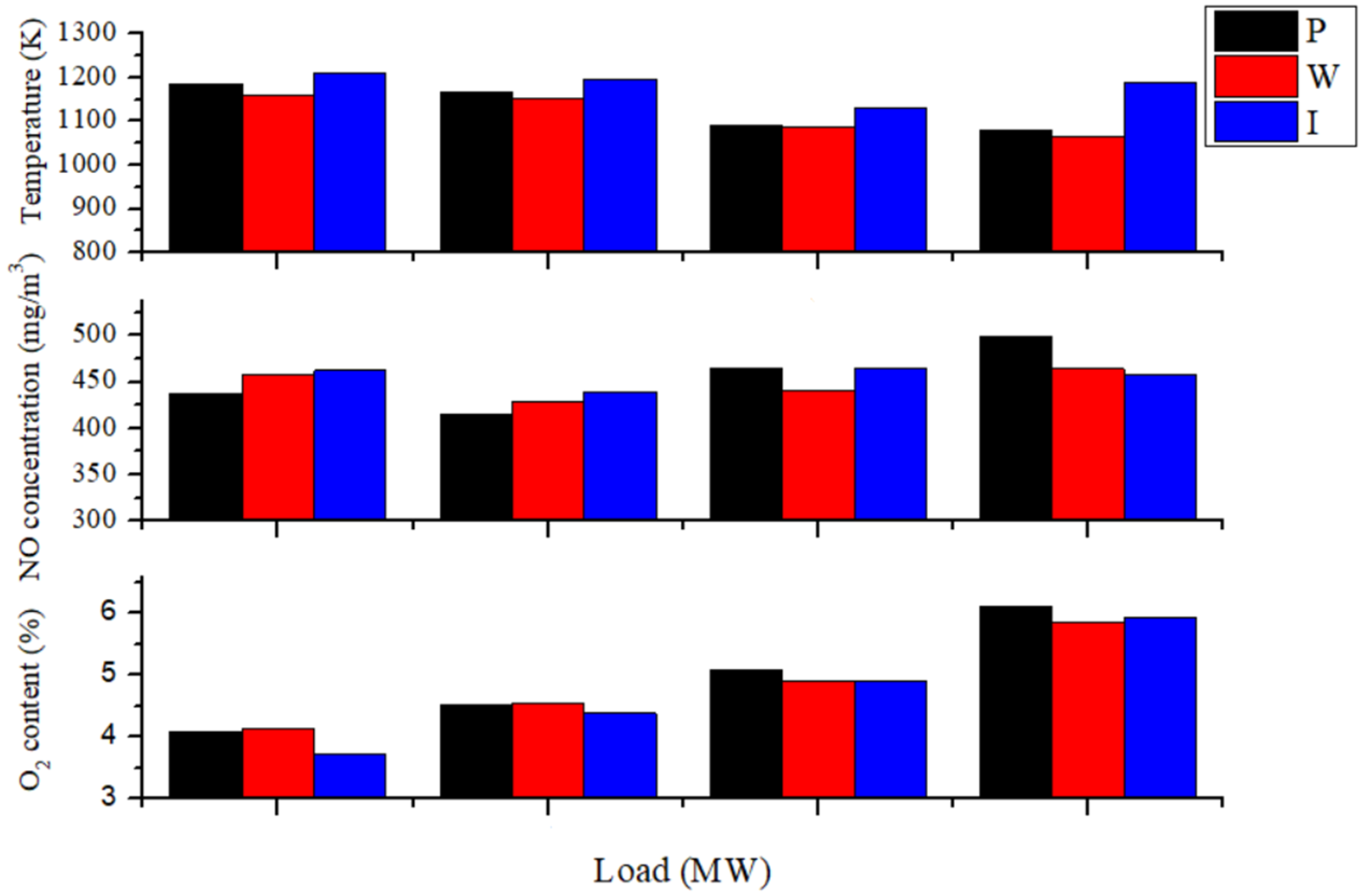
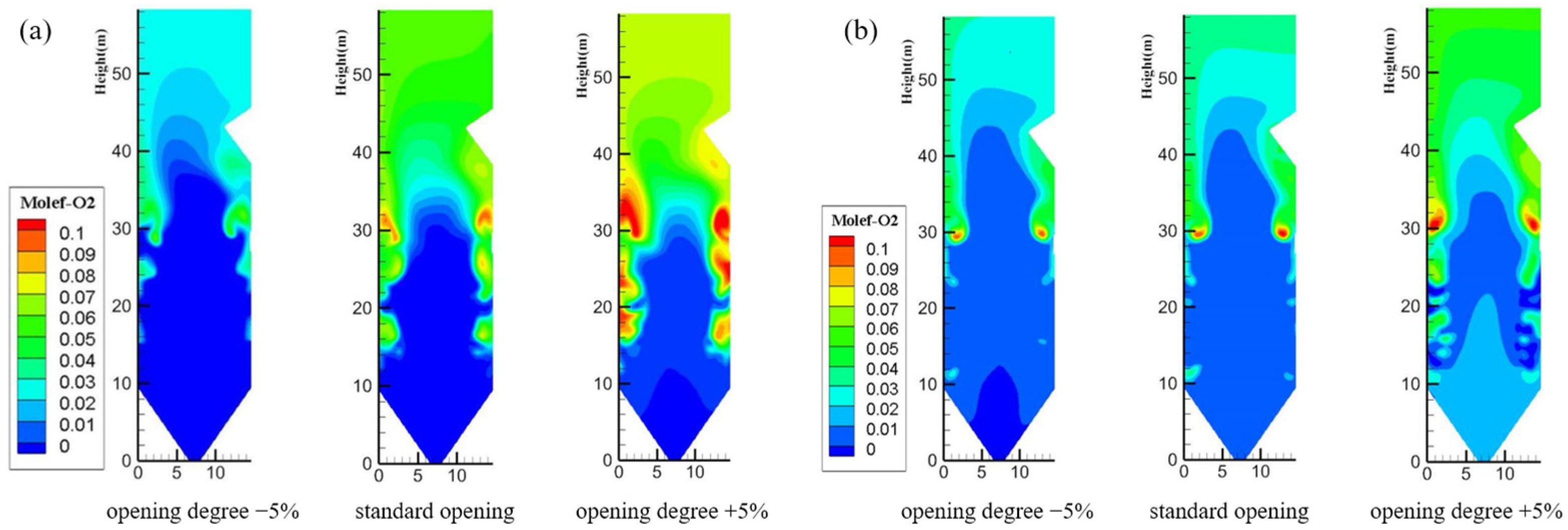
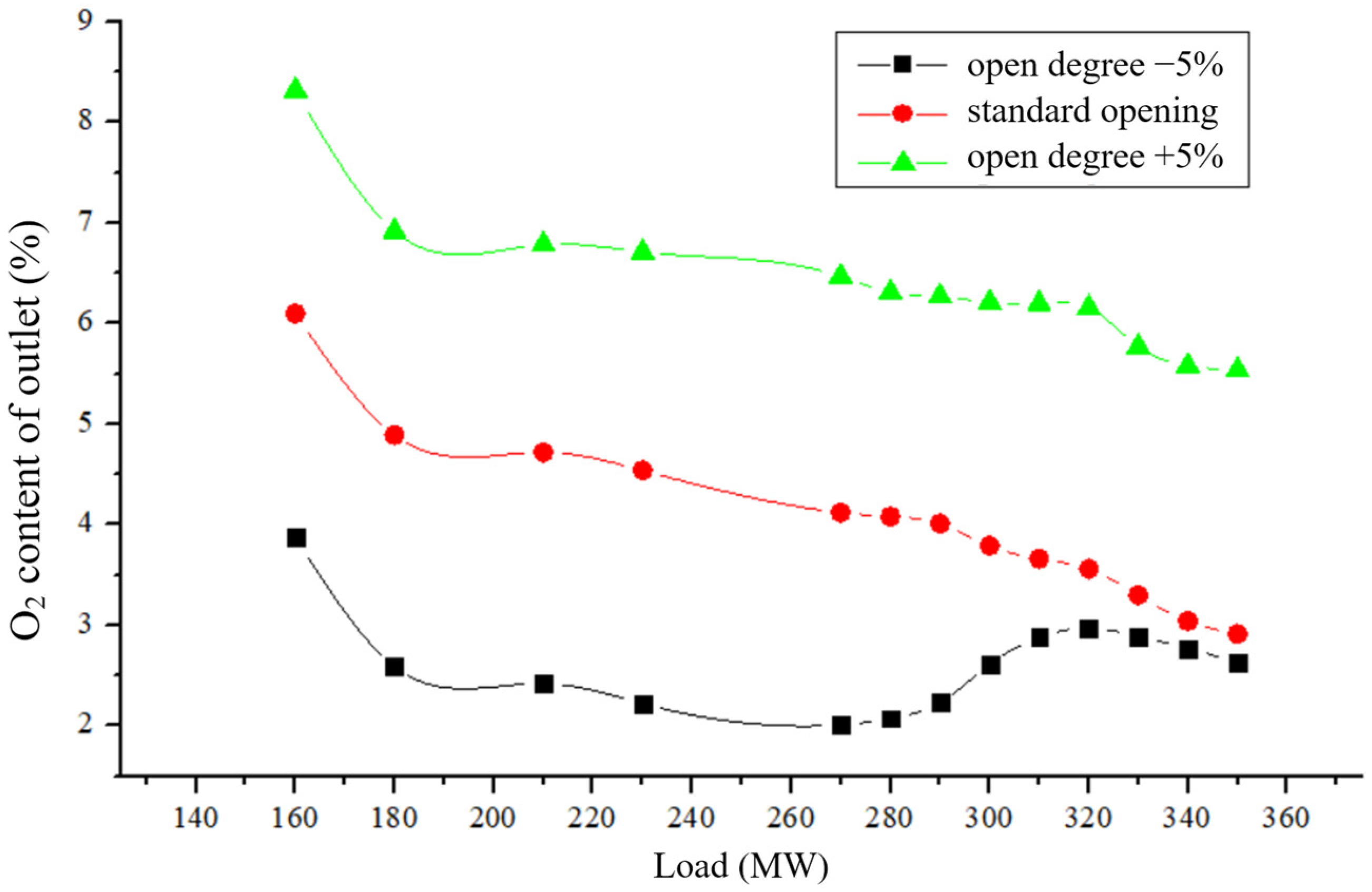
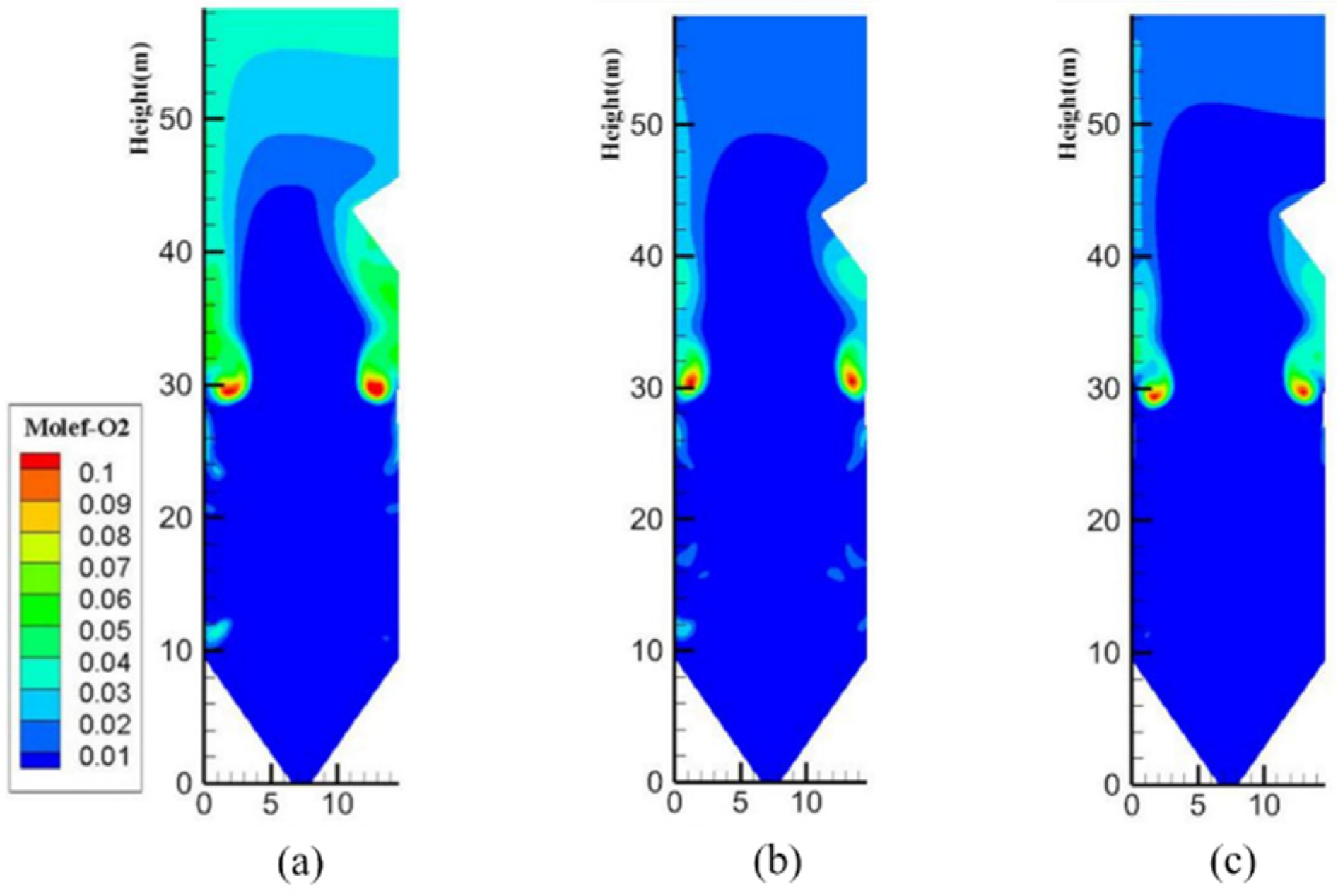
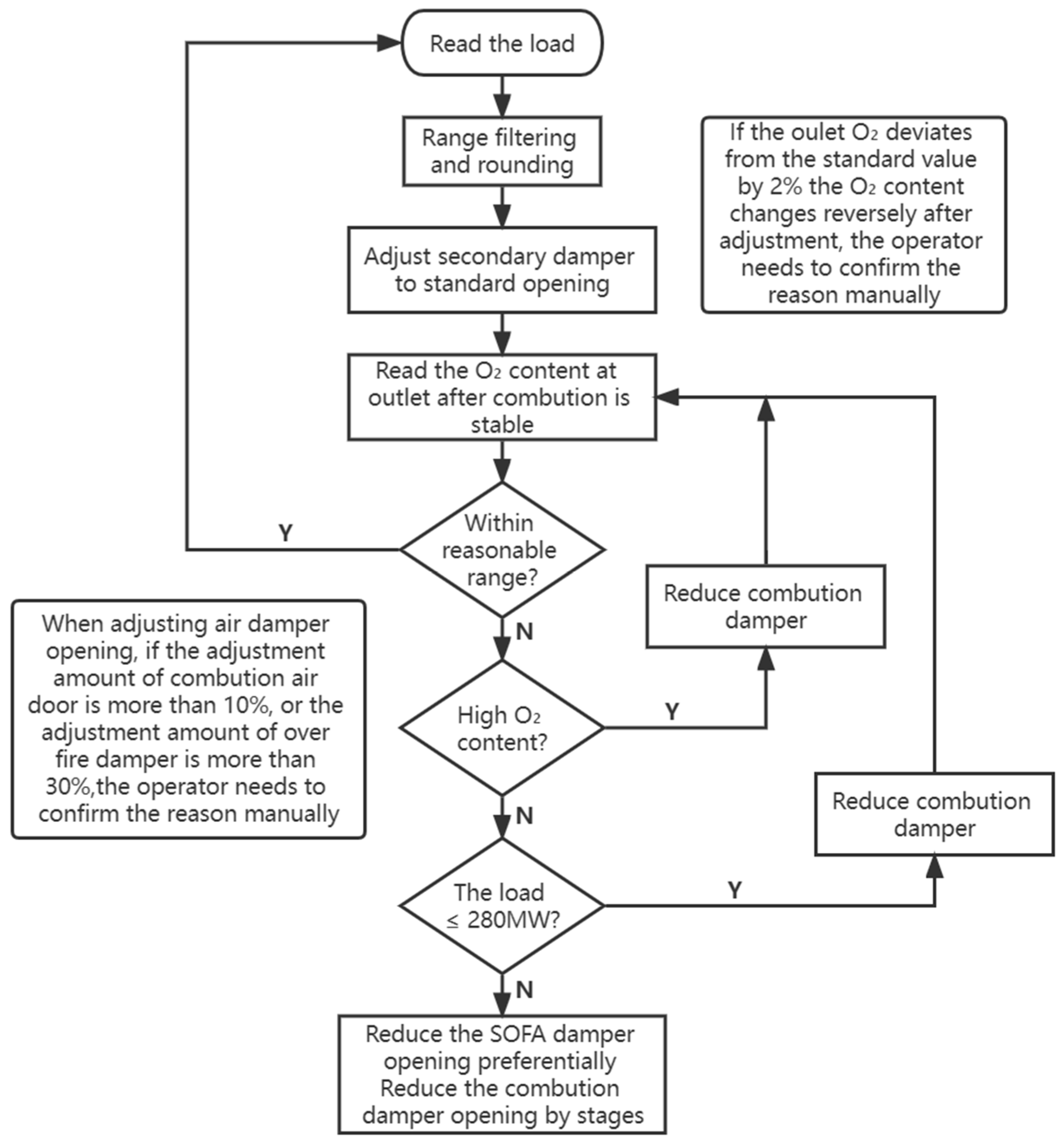
| 350 MW | 320 MW | 280 MW | 230 MW | 180 MW | 160 MW | |||||||||
|---|---|---|---|---|---|---|---|---|---|---|---|---|---|---|
| Coal Powder Consumption | 235.6 | 216.2 | 185.9 | 163.4 | 125.6 | 112.5 | ||||||||
| Industrial Analysis | Elemental Analysis | |||||||||||||
| 32.4 | 14.2 | 15 | 49.28 | 38.27 | 3.25 | 9.92 | 0.73 | 0.43 | 13.50 | |||||
| c1 | c2 | c3 | c4 | c5 | |
|---|---|---|---|---|---|
| O2 | 834.826 | 0.293 | −1.495 × 10−3 | 3.414 × 10−7 | −2.278 × 10−10 |
| N2 | 979.043 | 0.417 | −1.176 × 10−3 | 1.674 × 10−6 | −7.251 × 10−10 |
| CO | 968.394 | 0.449 | −1.152 × 10−3 | 1.657 × 10−6 | −7.346 × 10−10 |
| CO2 | 429.930 | 1.874 | −1.966 × 10−3 | 1.297 × 10−6 | −3.999 × 10−10 |
| H2O | 1563.082 | 1.604 | −2.932 × 10−3 | 3.216 × 10−6 | −1.156 × 10−9 |
| 350 MW | 320 MW | 280 MW | 230 MW | 180 MW | 160 MW | |
|---|---|---|---|---|---|---|
| Open dampers | BCDEF | BCDEF | BCEF | BCEF | CEF | CEF |
| Temperature | 383 | 373 | 363 | 353 | 343 | 333 |
| 350 MW | 320 MW | 280 MW | 230 MW | 180 MW | 160 MW | |
|---|---|---|---|---|---|---|
| Temperature | 648 | 633 | 624 | 617 | 608 | 604 |
| 350 MW | 320 MW | 280 MW | 230 MW | 180 MW | 160 MW | |
|---|---|---|---|---|---|---|
| Open dampers | S1234 | S1234 | S234 | S234 | S24 | S24 |
| S1 | 100 | 80 | - | - | - | - |
| S2 | 100 | 80 | 80 | 80 | 80 | 50 |
| S3 | 100 | 80 | 80 | 50 | - | - |
| S4 | 100 | 80 | 80 | 80 | 80 | 50 |
| Boiler Load (MW) | 350 | 320 | 280 | 230 | 180 | 160 |
|---|---|---|---|---|---|---|
| Average outlet temperature | 1258 | 1222 | 1194 | 1160 | 1096 | 1074 |
| Boiler Load (MW) | 160–180 | 180–230 | 230–280 | 280–320 | 320–350 |
|---|---|---|---|---|---|
| Outlet average oxygen content | 6–5 | 5–4.5 | 4.5–4 | 4–3.5 | 3.5–3 |
| Air Dampers | 280 MW | 230 MW | 180 MW | 160 MW | ||||||||
|---|---|---|---|---|---|---|---|---|---|---|---|---|
| P | W | I | P | W | I | P | W | I | P | W | I | |
| AA | 20 | 30 | 30 | 15 | 20 | 20 | 15 | 20 | 20 | 10 | 20 | 20 |
| AB | 20 | 30 | 30 | 15 | 20 | 20 | 15 | 20 | 20 | 10 | 15 | 15 |
| BC | 20 | 20 | 30 | 20 | 20 | 20 | 15 | 15 | 20 | 15 | 15 | 15 |
| CC | 20 | 20 | 20 | 20 | 15 | 20 | 15 | 15 | 15 | 15 | 10 | 15 |
| DD | 30 | 20 | 20 | 20 | 15 | 20 | 20 | 15 | 15 | 15 | 10 | 15 |
| DE | 30 | 20 | 20 | 20 | 20 | 15 | 20 | 15 | 15 | 15 | 15 | 10 |
| EF | 30 | 30 | 20 | 20 | 20 | 15 | 20 | 15 | 15 | 20 | 15 | 10 |
| FF | 30 | 30 | 30 | 30 | 30 | 30 | 20 | 20 | 20 | 20 | 20 | 20 |
| Combustion Air Dampers | 160 MW | 180 MW | 230 MW | 280 MW |
|---|---|---|---|---|
| AA | 10 | 20 | 20 | 20 |
| AB | 10 | 20 | 20 | 20 |
| BC | 15 | 15 | 20 | 20 |
| CC | 15 | 15 | 15 | 20 |
| DD | 15 | 15 | 15 | 30 |
| DE | 15 | 15 | 20 | 30 |
| EF | 20 | 20 | 20 | 30 |
| FF | 20 | 20 | 30 | 30 |
| Load (MW) | 350 | 340 | 330 | 320 | 310 | 300 | 290 | 280 |
|---|---|---|---|---|---|---|---|---|
| Dampers open | S1234 | S1234 | S1234 | S1234 | S1234 | S1234 | S1234 | S234 |
| Opening degree | ||||||||
| S1 | 100 | 94 | 87 | 80 | 60 | 40 | 20 | - |
| S2 | 100 | 94 | 87 | 80 | 80 | 80 | 80 | 80 |
| S3 | 100 | 94 | 87 | 80 | 80 | 80 | 80 | 80 |
| S4 | 100 | 94 | 87 | 80 | 80 | 80 | 80 | 80 |
| Load (MW) | Adjustment Mode | Outlet Oxygen Content (%) |
|---|---|---|
| 350 | Standard opening | 2.91 |
| Combustion air −5% | 2.63 | |
| Combustion air −10% | 1.77 | |
| Combustion air −15% | 0.59 | |
| 340 | Standard opening | 3.04 |
| SOFA air −7% | 2.54 | |
| SOFA air −7%, Combustion air −5% | 1.83 | |
| SOFA air −7%, Combustion air −10% | 0.88 | |
| 330 | Standard opening | 3.3 |
| SOFA air −13% | 1.72 | |
| SOFA air −13%, Combustion air −5% | 1.14 | |
| 320 | Standard opening | 3.56 |
| SOFA air −20% | 1.33 | |
| 310 | Standard opening | 3.66 |
| SOFA air −20% | 1.37 | |
| 300 | Standard opening | 3.79 |
| SOFA air −20% | 1.54 | |
| 290 | Standard opening | 4.01 |
| SOFA air −20% | 1.91 |
Disclaimer/Publisher’s Note: The statements, opinions and data contained in all publications are solely those of the individual author(s) and contributor(s) and not of MDPI and/or the editor(s). MDPI and/or the editor(s) disclaim responsibility for any injury to people or property resulting from any ideas, methods, instructions or products referred to in the content. |
© 2022 by the authors. Licensee MDPI, Basel, Switzerland. This article is an open access article distributed under the terms and conditions of the Creative Commons Attribution (CC BY) license (https://creativecommons.org/licenses/by/4.0/).
Share and Cite
Jin, Y.; Sun, Y.; Zhang, Y.; Jiang, Z. Research on Air Distribution Control Strategy of Supercritical Boiler. Energies 2023, 16, 458. https://doi.org/10.3390/en16010458
Jin Y, Sun Y, Zhang Y, Jiang Z. Research on Air Distribution Control Strategy of Supercritical Boiler. Energies. 2023; 16(1):458. https://doi.org/10.3390/en16010458
Chicago/Turabian StyleJin, Yingai, Yanwei Sun, Yuanbo Zhang, and Zhipeng Jiang. 2023. "Research on Air Distribution Control Strategy of Supercritical Boiler" Energies 16, no. 1: 458. https://doi.org/10.3390/en16010458
APA StyleJin, Y., Sun, Y., Zhang, Y., & Jiang, Z. (2023). Research on Air Distribution Control Strategy of Supercritical Boiler. Energies, 16(1), 458. https://doi.org/10.3390/en16010458






